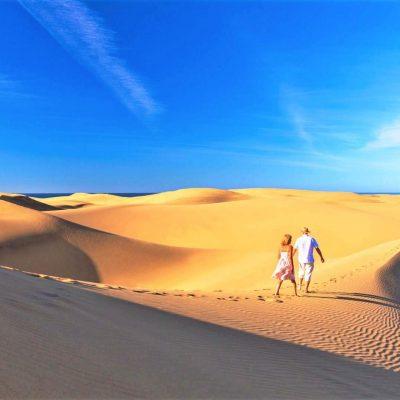Calima in Tenerife is the presence of a dense layer of yellowish dust suspended in the air. You will be able to notice this phenomenon because of the low visibility in the air, accompanied by an intense sensation of heat. If you are going on holiday to Tenerife, you will be interested to know the following points:
- What is Calima?
- Origin
- Effects on health and the environment
What is Calima?

It is a phenomenon caused by the arrival of dust from the Sahara and Sahel deserts, transported by the air currents that reach Tenerife from the east and southeast. The dust floods the atmosphere generating a dry fog and layers of dust on everything in its path.
The name Calima was coined by the locals, but it is also often called “Siroco” which is the name of the wind responsible for dragging the sand. The word Calima comes from the Latin “caligo” or “caliginis” used to refer to the dense mist that darkened the atmosphere. The term Calima is still used by professionals, although it is not included in the International Meteorological Vocabulary of the World Meteorological Organization (WMO).
A distinction is made between Type A and Type B Calima. Calima type A, characterised by fine dust from the desert, occurs in Tenerife. Calima B, on the other hand, also contains ashes from fires and polluting particles from factories. The absorption of Calima type B is harmful to health.
Origin of the calima in Tenerife?
It comes from sandstorms in the Sahara desert, caused by strong winds. Winds from the southeast then carry large quantities of sand to the Canary Islands, generating a haze of dust over the archipelago.
Depending on the wind direction, the sand can reach the Balearic Islands, the mainland or other European countries. In the Canary Islands, the most affected islands are Gran Canaria, Lanzarote, La Graciosa and Fuerteventura.
Effects on health and the environment
Calima in Tenerife does not cause major problems, however, it usually causes some undesirable effects such as:
- Reduction of visibility. This meteorological phenomenon makes it impossible to see over long distances, although the haze depends on the intensity of the haze. When it is extreme, it reduces visibility by less than one kilometre.
- Decreased visibility.
- Decreased air quality, causing respiratory problems. It is especially of concern to allergy sufferers, so they should take precautions. It can cause red eyes, sore throat and breathing difficulties. Some people experience headache and fatigue.
- Warm temperature. Tourists who come to Tenerife to escape the cold find La Calima pleasant.
- Tourists who come to Tenerife to escape the cold find La Calima pleasant.
- Layers of sand everywhere. La Calima leaves streets, houses and cars under layers of sand.
- Sensation of twilight. For tourists, it’s a strange sight, going out and seeing the yellowish sky and an ochre tint to the atmosphere, as if they were wearing coloured glasses.
- Combined with the sunset, it’s a strange sight.
- Combined with the rainfall, it causes the so-called “mud showers”. This occurs only on the Mediterranean coast of Spain.
Not everything is negative, the presence of Calima in Tenerife generates beautiful skies and dreamy sunsets with beautiful reddish and orange tones. Visitors come away with beautiful photographs that look like they were taken with filters.
What time of the year does Calima occur?
It occurs several times a year, being more common in the summer months when the air is warmer. A prerequisite for Calima to occur is the presence of dry air in the atmosphere, which differentiates it from the haze caused by humid air suspended in the atmosphere.
Calima in Tenerife usually occurs between the months of February and August. If you want to keep up to date with the current weather in Tenerife, check the following website:
https://www.accuweather.com/en/es/santa-cruz-de-tenerife/303003/weather-forecast/303003
How long does the Calima last?
It is a phenomenon of short duration. It can take a few hours or extend up to 7 days. The effect is strongest at first, then the sky clears until the haze disappears completely. The duration of the Calima depends on the strength and direction of the wind, as well as the weather conditions in Tenerife.
Recommendations for staying safe
It should be noted that you should first of all follow the recommendations of the relevant official authorities. We are not responsible for your health.
If you are on holiday on the island during Calima you should not worry, follow the following recommendations issued by the health authorities:
- Staying hydrated
- Avoid prolonged outdoor activities
- When outdoors, keep in the shade and wear a face mask.
- Wear light clothing, sunglasses and sunscreen.
- Park your car indoors
- Keep doors and windows closed
- Wait for the Calima to pass to enjoy the sea.
Also see the following web and make sure to follow its indications. Especially if you suffer from respiratory illnesses, consult your doctor.
It is important to keep an eye on weather forecasts to prepare for the arrival of Calima. Keep up to date with the weather and the recommendations of the health centres.













